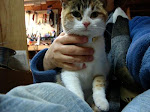 |
| Man and Child Drinking Tea, attributed to Richard Collins (died 1732) |
 |
| Elizabeth Bothem & Sons Tea Rooms, Whitby, England, a classic setting. |
The recent pilgrimage to the ancestral homeland was, of course, delightful & invigorating on many levels. But it was a shock to see the extent of change on a number of subjects since just five years before. Some better (the slow food movement has swept the restaurant world there, British cuisine is no longer a joke), some worse. And this is about some worse... Should you think Mr. Fuzzy is making a mountain from a mole hill, consider that a tax on tea sparked the Boston Tea Party, leading to the American Revolution. You had better believe the Founding Fathers took tea seriously.
 |
| Teapot by Paul Revere, c. 1760-65 |
Most readers will know Mr. Fuzzy well and realize that he suffers from one serious addiction: tea, especially hot tea (yes, I drink hot tea at breakfast all year). Tea is a very important facet of life at Stratheden Farms and Mr. Fuzzy might be accused of resembling a tea snob at times. Nolo contendere.
 |
| B&B owner Rodney (Kelso, Scotland) about to gift his tea cozy |
The BBC recently aired this video about contemporary British tea drinking; your humble correspondent was apoplectic that a tea bag was used rather than loose tea. The end of western civilization is bound to be near.
 |
| A setting at The Old Rectory, Callander, Scotland. |
With the exception of one modest restaurant in rural Scotland, the only proper teas were to be found in dedicated tea rooms. It is especially offensive to see tea served in a thin stainless steel pot (the same as is used in the U.S.A.) which holds only one cup and a fraction, cools far too quickly and imparts taste to that golden liquor that nature never intended.
A proper tea service consists of:
1. tea pot
2. tea kettle
to heat water, perhaps mounted on a stand with a self contained heat source
3. hot water pot
to dilute tea which has gained too much strength in brewing
4. strainer
to filter out the tea leaves
5. sugar bowl(s)
two: one with demerara and one with white sugar
6. waste bowl
to receive the tea leaves removed by the strainer
7. milk pitcher
8. tea spoon
to stir the tea in the cup to admix the milk and/or dissolve the sugar
9. a tea cozy
in winter or in a chilly or drafty room, an insulated cover placed over the pot to aid in heat retention
and ideally, a tea caddy or tea chest and all placed on a correct tea table.
The process of making tea:
1. Pre-warm the tea pot by swishing a cup or so of warm water around in it. This warms the pot and prevents it from draining the heat from the tea as quickly, and, if the pot is very old, or cheaply made, this step may prevent the glaze from crazing due to thermal shock.
2. Bring cold water to a boil then pour over tea leave. For every type of tea n your tea chest, determine an optimal brewing time and measure it carefully.
3. At the optimal brewing period pour the liquor through a tea strainer to capture the loose leaves as you fill the cups.
 |
| Sterling silver tea strainer |
5. Add a sugar, demerara cubes or white sugar (granular or in cubes) to taste. Demerara sugar is not just different in appearance but most importantly, in flavour. Note the demerara cube on the saucer as served at The Old Rectory.
 |
| Staffordshire tea pot circa 1775 |





No comments:
Post a Comment